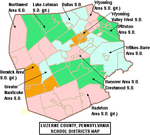Greater Pittston
Geography of Luzerne County, PennsylvaniaPittston, Pennsylvania

Greater Pittston is a 65.35 sq mi (169.3 km2) region in Luzerne County, Pennsylvania, in reference to the area in and around Pittston. As of 2010, the total population of Greater Pittston is 48,020. This region includes Avoca, Dupont, Duryea, Exeter Boro, Exeter Township, Hughestown, Jenkins Township, Laflin, Pittston Township, West Pittston, West Wyoming, Wyoming, and Yatesville. It is a subregion of Wyoming Valley.
Excerpt from the Wikipedia article Greater Pittston (License: CC BY-SA 3.0, Authors, Images).Greater Pittston
Butler Alley,
Geographical coordinates (GPS) Address Nearby Places Show on map
Geographical coordinates (GPS)
| Latitude | Longitude |
|---|---|
| N 41.323888888889 ° | E -75.788888888889 ° |
Address
Butler Alley 55
18640
Pennsylvania, United States
Open on Google Maps










